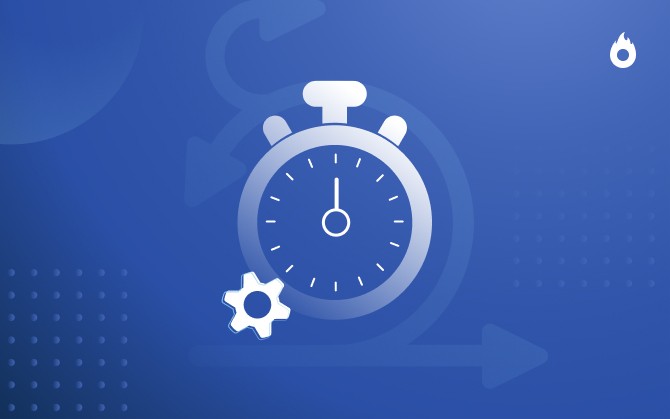
Scrum: How to use this methodology in your projects
Learn about the SCRUM methodology and its advantages for new product development!

What will we see in this post
At some point, you must have found it difficult to execute a project. When something doesn’t seem to go quite right, or the team is not aligned, and what’s worse, many problems appear along the way.
It’s at this point that it’s necessary to invest in work methodologies to create greater fluidity between tasks, ensure that all professionals are in sync, and offer satisfactory results for customers and the business.
This is where the SCRUM methodology comes into play and creates greater dynamism during product development. If you’re curious to learn more about this task management technique, check out our article!
What is SCRUM?
SCRUM is a widely used framework in the tech industry for developing and delivering highly complex work that often requires collective work.
In simpler terms, we can say that this methodology is used to improve processes in the creation of products, a means of managing the stages of each project.
However, going beyond simple improvement, this method helps optimize joint projects, providing greater creativity, adaptation, and making it easier to find solutions and achieve effective results.
What is Agile Methodology?
Before we delve into the SCRUM methodology, it’s important that you know a little about the Agile methodology.
Also widely used in tech companies, it encompasses practices and principles of the Agile Manifesto, which is a declaration of core values in software development created in February 2001.
The Agile methodology seeks to follow planning and execution techniques that ensure successful results in the development of these tools and products.
SCRUM comes in to implement this method. It’s as if Agile created the concept and SCRUM created a path, a practical structure for it. There are a few agile methodologies, and SCRUM is one of them.
You might be confused and not know how it can be applicable to your business, but we will, throughout this article, take a closer look at the SCRUM methodology’s elements and activities and show you how it can be used in your projects.
How did SCRUM come about?
The first mention of SCRUM was made in 1986 in an article written by Hirotaka Takeuchi and Ikujiro Nonaka called “The New New Product Development Game“.
The idea was to compare a model for product development with Rugby, so much so that SCRUM is also the name of a well-known play in this sport.
However, the methodology was only truly developed by Jeff Sutherland and Ken Schwaber in 1993 in order to change the management of software creation.
What are the SCRUM elements?
Now that you know a little more about SCRUM, let’s introduce this framework’s main elements, where each team will act during the product development stages. Shall we get started?
Product Backlog
The Product Backlog acts as a means of grouping all the steps, tasks, functionalities and features that the product to be developed needs.
Let’s suppose that you want to launch a new product and you need to list what it will look like, what needs to be done… This list is the product backlog. All actions, new tasks and steps are put into this SCRUM element.
Sprint Backlog
If the Product Backlog groups all of the product’s features and actions, the Sprint Backlog is what defines the demands that will be prioritized and the team’s execution time.
The goal is to be able to complete each stage, but especially to do this in a smart way, distributing the tasks equally among the team and ensuring results that add value to the product being developed.
Sprint
Sprint refers exclusively to the period of execution of the actions that appear in the sprint backlog. This period usually lasts between 2 and 4 weeks.
Sprint is critical for SCRUM to work! Through it, the action cycles work more effectively. However, you need to be aware of certain rules related to the Sprint, such as:
- You have to deliver value with good quality goals
- You have to keep an eye out for changes during the processes so that they don’t affect the Sprint period
Key roles in project management with SCRUM
During the SCRUM methodology, teams can assume 3 key roles for good project management, which are Product Owner, Scrum Master, and Scrum Team!
Product Owner
The Product Owner is the person responsible for coordinating the demands, reaching an agreement with each team member, and making the sprints work in full harmony.
This member will have an important role in organizing the product backlog and handing out tasks according to what needs to be prioritized. This professional needs to have a 360° view of the product, understand the team’s deliverables, and assist the teams whenever necessary.
Scrum Master
This professional leads the team in executing the sprints, helping balance the workflow, maintaining the team’s focus, and increasing productivity.
Therefore, we can say that the Scrum Master is a facilitator during the product development process. They don’t act in the same comprehensive manner as the Product Owner, nor do they have the same leadership role, but they’re a key part in making the deliveries happen and work alongside the other roles within the SCRUM.
Scrum Team
The Scrum Team is merely the team that assists in each stage of the product. It is responsible for executing the Sprints and requires organized, focused, and collaborative professionals to equally distribute goals and responsibilities.
What are the main activities of the SCRUM methodology?
Within each element, and through each role of the SCRUM methodology, there are specific activities that optimize processes and help project members. Learn more about the main ones:
Daily Meeting
A daily meeting, with up to 15 minutes for each professional to present what they have done and what they will do regarding their tasks.
A few questions were answered during this meeting, such as, “What did I do yesterday that helped deliver the Sprint?”, “What will I do today to help in completing the Sprint?” and “What are the impediments or difficulties for the Sprint?”
In the Daily Meeting, the Product Owner’s participation isn’t necessary since they follow the development of the Sprints on a daily basis.
Sprint Planning
Sprint planning is the first moment of the Sprint application that is about to begin.
This is where the priorities of what will be delivered are understood and defined. This planning takes place between the product backlog and the Sprint backlog and comes after the Product Owner has determined the priorities as a way for the team to narrow down this list of tasks and understand what can be delivered and now to deliver it.
Sprint Review
When the Sprint is delivered, it’s necessary to gather what has been completed and perform a review to analyze the work as a whole. This review is often performed by the Product Owner or by others who are interested in completing the task.
Certain steps are prioritized during the review, such as understanding what was delivered, what the difficulties were, and how they were overcome, answering the Product Owner’s questions, and knowing what the next steps will be.
It’s also the opportunity to obtain feedback from customers and changes if needed.
Sprint Retrospective
While the review focuses on what has been delivered, the retrospective evaluates the methods used in executing the previous Sprint.
This analysis adds improvements to the development processes and takes advantage of actions that have worked well before. This meeting takes place after the Sprint Review and before the planning of the next Sprint.
With this, the work will be perfected, and the cycle becomes increasingly easier with quality deliveries.
What are the advantages of the SCRUM methodology?
The SCRUM methodology optimizes your team, speeds up project delivery, improves productivity, and keeps the team even more aligned and organized throughout the process.
Another positive point is the ease that everyone finds when it comes to analyzing and identifying points for improvement, ensuring multiplied and balanced work.
SCRUM contributes to developing a minimum viable product (MVP) and in the online universe and can be used for digital products, website development, landing pages, campaigns, and other services/products that require this fast and assertive work.
This method will strengthen the team and the professional areas that are part of it, preventing major faults from arising in specific sectors. Everyone works with the objective of minimizing problems and carrying out a job well done.
It’s time to apply the SCRUM methodology to your projects!
Today, you learned more about the SCRUM methodology and that it can be applied in several sectors that go beyond software development.
It contains elements (product backlog, sprint backlog, sprint), roles (product owner, scrum master, and scrum team), and activities (daily meeting, sprint planning, sprint review, and sprint retrospective) that facilitate group project development.
This is a business management model that, like many others, requires strategic planning and an entrepreneurial mindset at each stage in order for the sprints to be completed successfully. On that note, we have a blog post about 10 skills entrepreneurs need to build a thriving business. Ready to become an even better entrepreneur?




